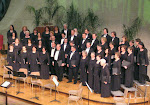
So our Spring Concert took place last weekend at the Pasadena Presbyterian Church, a new venue for us, and an impressive one with its striking modern architecture and unusual stain-glassed windows. We started with our Morely and Arcadelt madrigals and sang them with a lot of spirit and rhythmic verve, or so it seemed to me. And the ladies and Colburn Children's Choir sang their Rachmaninoff piece, The Angel, well, angelically. The Song I Sing was a lively finish for the Chorale's first half; the audience certainly seemed to like the unusual mixture of pop, jazz, rap and Handel contained in the arrangement. Pop, jazz, rap and Handel--fun now and then, but for obvious health reasons I wouldn't take that mixture too often.
The Colburn choir followed with a beautiful set of folk and contemporary pieces, singing with precision and a truly lovely blend of treble voices, all showing Misha's loving hand as their director.
In the second half the Chorale turned to Fauré, with the orchestra in hand and with our own John Tveit at the church's towering new pipe organ. The Cantique is, of course, a lovely piece, a glorious little chestnut written by a teenage composer (and fantastically labelled "Op. 11" by a publisher who wanted Fauré to seem more experienced). If our French wasn't "native," our love of the music, I'm confident, more than made up for it. We all love singing the piece and I know that must have shown through.
Then came the Requiem. I first encountered the Fauré Requiem in high school when I had the experience of singing the Sanctus, the third section of the mass, with its flowing lines that lead up to those mighty "Hosannas." That led me to buy a recording, and I have listened to it from time to time with much pleasure over the years.
But occasional listening is really nothing compared to the experience of learning, singing and living with this masterpiece over several months. It's one of those special pieces, I think, in which the composer was simply inspired from start to finish--inspired to write beautiful and inventive harmonies, haunting and ravishing melodies, and to capture the text with absolute perfection. Consider the perfectly brooding "Requiem aeternam" that, at the very start, seems to bring us to death's doorstep, leading us right into a lovely but elegiac Kyrie. Then comes the whispering, almost ghost-like alto and tenor duet in the Offertory, with harmonies that sound distinctly modern yet timeless. Then the above-mentioned Sanctus momentarily raises the spirit and leads to the famous Pie Jesu that mixes loveliness and solemnity in appropriately equal proportions.
Next is my personal favorite, the Agnus Dei section; I wonder how many feel the same. It seems to be a whole mass in itself, with its beloved and beautiful obbligato intro, its melodic main theme (I'm happy that the tenors got it) and the ensuing chromaticism in which Fauré explores the depths of the text--all ending with that obbligato theme. Then, in the Libera Me, we seek liberation from death in a deep baritone, leading to Fauré's "touch" of a Dies Irae section with its driving beat and insistent plea. Finally, using a text from a liturgical prayer not found in the standard Requiem Mass, Fauré creates what seems to be the perfect "stairway to heaven." With its steady, flowing arpeggios, and its most gentle yet slightly mysterious melody, it seems to say, "if you've gotta go, this is your exit music, this is what angels actually sound like when they sing you to final sleep."
So that's a mouthful, and apologies for any excess. But to me there's nothing like this piece. It's a genre to itself. Innovative and accessible, gentle and powerful, I feel sure that it moved all of us one way or another. I personally thank our maestro (and my fellow choir members) for the unforgettable experience of communing with it over the course of four months! And a THANKS to all those who worked so hard to make the concert turn out well. On to Mozart and Handel for Christmas!

